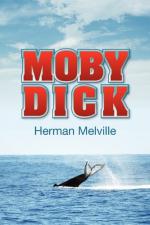In the English boats two tubs are used instead of one; the same line being continuously coiled in both tubs. There is some advantage in this; because these twin-tubs being so small they fit more readily into the boat, and do not strain it so much; whereas, the American tub, nearly three feet in diameter and of proportionate depth, makes a rather bulky freight for a craft whose planks are but one-half inch in thickness; for the bottom of the whale-boat is like critical ice, which will bear up a considerable distributed weight, but not very much of a concentrated one. When the painted canvas cover is clapped on the american line-tub, the boat looks as if it were pulling off with a prodigious great wedding-cake to present to the whales.
Both ends of the line are exposed; the lower end terminating in an eye-splice or loop coming up from the bottom against the side of the tub, and hanging over its edge completely disengaged from everything. This arrangement of the lower end is necessary on two accounts. First: In order to facilitate the fastening to it of an additional line from a neighboring boat, in case the stricken whale should sound so deep as to threaten to carry off the entire line originally attached to the harpoon. In these instances, the whale of course is shifted like a mug of ale, as it were, from the one boat to the other; though the first boat always hovers at hand to assist its consort. Second: This arrangement is indispensable for common safety’s sake; for were the lower end of the line in any way attached to the boat, and were the whale then to run the line out to the end almost in a single, smoking minute as he sometimes does, he would not stop there, for the doomed boat would infallibly be dragged down after him into the profundity of the sea; and in that case no town-crier would ever find her again.
Before lowering the boat for the chase, the upper end of the line is taken aft from the tub, and passing round the loggerhead there, is again carried forward the entire length of the boat, resting crosswise upon the loom or handle of every man’s oar, so that it jogs against his wrist in rowing; and also passing between the men, as they alternately sit at the opposite gunwales, to the leaded chocks or grooves in the extreme pointed prow of the boat, where a wooden pin or skewer the size of a common quill, prevents it from slipping out. From the chocks it hangs in a slight festoon over the bows, and is then passed inside the boat again; and some ten or twenty fathoms (called box-line) being coiled upon the box in the bows, it continues its way to the gunwale still a little further aft, and is then attached to the short-warp— the rope which is immediately connected with the harpoon; but previous to that connexion, the short-warp goes through sundry mystifications too tedious to detail.




